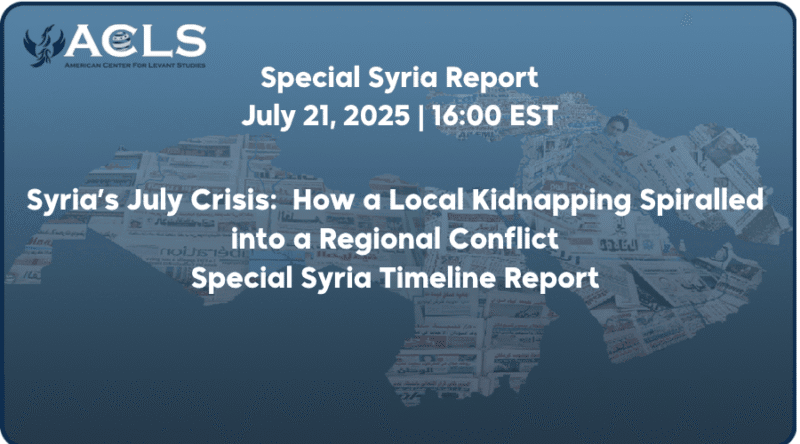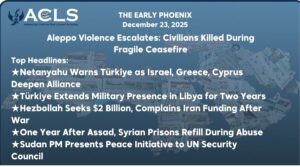Executive Summary:
A seemingly minor robbery incident in southern Syria last week cascaded into international warfare involving sectarian violence, Israeli military intervention, and ultimately forced Syrian government withdrawal from Sweida. The crisis has claimed 1,120+ deaths, including 194 documented field executions since July 13. Druze militias executed Bedouin civilians and burned homes following government withdrawal, while a captured fighter confessed that 200-300 foreign Uzbek/Turkestani fighters participated in attacks against Druze civilians under orders for “sectarian genocide.” Israel struck Damascus General Staff building and presidential palace July 16, forcing unprecedented Syrian territorial concessions. U.S. Envoy Barrack announced ceasefire July 21 with prisoner exchange arrangements underway, but sectarian violence continues as Syrian buses evacuate 1,500 Bedouin civilians while tribal fighters attempt rescue of kidnapped women and children. Jordan’s Bedouin council threatened Israeli personnel, creating cross-border escalation risks. Given Israel’s unprecedented targeting of Syrian command infrastructure and documented foreign fighter involvement, the region faces escalating risks that can destabilize broader Levantine security architecture.
This timeline below provides a critical case study in escalation dynamics emerging in the New Syria. The Sweida incident follows similar patterns of previous clashes across Syria since early 2025 (See the reports last item titled: The Coast Massacres March 2025: Sharaa’s Delayed Transparency). However, Israel’s airstrikes on the Syrian government in Damascus represents an unprecedented escalation and has raised regional concerns about Israeli intentions. The bottom line is that the situation in Syria is so tense and fragile that even minor local security incidents have the potential to spiral into regional conflict.
===========

July 11: Driver Robbery Triggers Crisis
The cycle of abductions began when Bedouin tribesmen carjacked a Druze truck driver near Kherbet al-Shayeb and the First Corps area in rural Damascus on July 11, 2025 by unruly Arabian tribes who have a long history of committing these crimes across history. According to the Druze driver’s account, the Bedouins stole his vehicle, its contents, and 7 million Syrian pounds (approximately $695) and dumped him in a deserted area.
After the release of the Druze driver and publication of his testimony, violent clashes broke out. Druze gunmen attacked the Maqous neighborhood east of Suwayda—home to Bedouin tribes—attempting to free an additional 10 Druze detained earlier by Bedouin tribesmen, who were retaliating against Druze militants that had detained several Bedouins around the same time.
July 13: Damascus Intervenes
As the local fighting between Druze and Bedouins escalated, the Syrian Army intervened, ostensibly to “separate combatants” at locals’ request. Druze factions accused the army of siding with the tribes, though the media outlet Zaman al Wasel confirmed that tribes were not accompanying the Syrian army at that time. Having initially called for the army to intervene, Druze leader Hikmat al-Hijri hours later reversed his position, calling for armed resistance against the army. Druze fighters then ambushed and killed 14 Syrian security forces members who had arrived in Suwaydah to separate the warring parties. The Syrian Observatory reported that the death toll for the day was at least 166, including 21 field executions, with three women killed by Defense and Interior ministry personnel.
On the day of the Syrian army’s intervention into Suwaydah, Ahmad al-Sharaa was in Azerbaijan meeting with Israeli counterparts to negotiate an agreement concerning southern Syria. Sharaa and the Syrian interim government reportedly–and mistakenly–believed they had U.S. and Israeli consent to deploy forces in Sweida based on public and private messages, including U.S. envoy Thomas Barrack’s public comments supporting a centralized Syrian state. Syrian officials interpreted this comment as tacit approval to assert control over Druze areas and would later claim the security talks in Baku and the U.S. silence on the initial Syrian army advance reinforced that assumption.
July 14-15: Syrian Military Responds–And Sectarian Violence Escalates
On July 14, the Syrian Defense Ministry began mobilizing to attack the Druze militants who had killed 14 Syrian government security troops the day before. By July 15, the Syrian Observatory was reporting that Syrian Defense Ministry troops had arrived in Suwaydah and were committing killings reminiscent of the March 2025 coastal massacres, including attacks against local Druze medical personnel. Reports also began to note that the Syrian government forces committing these acts were accompanied by non-government militants, including Bedouin fighters.
Numerous mainstream media sources reported that Sweida residents documented serious violations, including executions, looting, and burning of homes, following the deployment of government forces and accompanying groups. Sweida 24 reported renewed violence in western Sweida countryside following surprise dawn drone attacks on villages and military vehicle advances from eastern Daraa, causing casualties and armed clashes between attacking forces and defending local factions and civilians.
Syria TV reported violations by groups accompanying government forces during Sweida military operations, despite civilian protection orders, with activists circulating videos of resident abuse and property theft that prompted widespread condemnation. Enab Baladi confirmed that violations escalated as groups accompanying government forces stormed Sweida’s Al-Radwan gathering hall, killing 15 civilians in what Al-Rased network called field executions, while also looting shops and forcing civilian displacement under circling warplanes.
Simultaneously in Daraa Governorate, gangs of gunmen from Sweida wounded four civilians including a woman and three children in Umm Walad, while other groups attacked Busra al-Harir with mortars, killing six Syrian soldiers. Druze residents in Maqous asked to be evacuated as tribal forces besieged their town after clashes between Druze and Bedouin fighters caused dozens of casualties.
As the clashes escalated, videos of sectarian abuses began to emerge. Zaman al Wasel documented 23 violations, including security forces shaving the mustaches of Druze leaders. Fifteen violations were against captured Druze fighters, and eight were against civilians.
One of the most disturbing incidents involved a massacre at a hospital in Sweida. The ICAD platform, an open-source intelligence investigation group, reported that the Sweida hospital massacre occurred while armed outlaw factions—not government forces—were in control of the facility. Through geolocation and timestamp analysis of verified videos, ICAD tracked the takeover of the hospital by militants on July 15 and their stated intent to eliminate Syrian security forces barricaded inside. The following day, video and interview evidence showed the militants claiming to have killed those forces. Government troops only retook the hospital later that afternoon, after which the massacre site and bodies—including civilians and security personnel—were discovered. ICAD’s findings directly challenge claims that Syrian government forces committed the killings.
Syrian army forces continued to battle outlawed groups and suffered personnel killed, wounded, and taken captive in the morning attacks on Monday, July 14. Activists circulated videos Monday showing Syrian army soldiers being tortured by Druze factions in Sweida. Four soldiers were killed and approximately 10 wounded in attacks by Druze groups targeting army units sent to break up the bloody fighting between tribal groups and local factions since Sunday.
July 14-16: Israeli Military Intervention
As the local clashes in and around Sweida increased, Israel launched multiple airstrikes on Syrian government military vehicles and infrastructure in Sweida on July 14-15. The Israelis targeted government forces and tanks near Samea village and al-Mazraa during clashes between Syrian forces, Bedouin tribes, and Druze militias, killing and wounding soldiers. Local Sweida factions counterattacked July 15, regaining key points, while both sides committed violations, including civilian deaths and looting. Syria’s Foreign Ministry condemned the Israeli intervention, but Defense Minister Abu Qasra on July 15 announced that the government had reached a ceasefire agreement with Sweida notables and would withdraw government forces from the governorate.
Despite Abu Qasra’s announcement, Israeli airstrikes expanded Wednesday, July 16, targeting Daraa, Damascus countryside, and the Damascus-Sweida road, striking the 132nd Brigade, Jabab and Muthabin towns, and killing three General Security officers at a checkpoint. Additional Israeli strikes hit Qatana outskirts and military equipment in Al-Kiswah.
The Israeli airstrikes reportedly surprised the Sharaa government, which, as noted above, claimed to have assumed it had a green light to intervene and quell the local violence between Druze and Bedouins. They also claimed to have misread Washington’s messaging, prompting Secretary of State Rubio to clarify that Israel had acted independently to counter escalating violence on the ground, not with any American endorsement.
Nevertheless, Syrian government forces continued to advance into eastern Sweida on July 16, despite the Israeli strikes and warnings, nearing full control as local factions retreated south and east.
July 16-17: Unprecedented Escalation and Syrian Withdrawal
In response to the continued moves by Syrian security forces, Israel, in a historically unprecedented move, struck prominent government targets in Damascus itself. One series of airstrikes demolished the Syrian Army’s General Staff building. Moments later, Israeli warplanes struck the presidential palace, rendering it uninhabitable. The strikes killed three people and injured 34 others, according to the Health Ministry. Syrian Civil Aviation temporarily closed the southern air corridor, and Daraa media official Hassan Ahmed al-Zoubi was killed with two media professionals injured covering Sweida events.
Following the Israeli escalation, Syrian President Sharaa announced during the early hours of Thursday, July 17, the withdrawal of Syrian army and internal security forces from Sweida, tasking local factions and religious leaders with maintaining security to avoid “open confrontation” with Israel. Sharaa said the government had intervened to halt internal fighting between armed groups stemming from long-standing disputes, but Israeli strikes on civilian and government facilities complicated the situation and pushed toward large-scale escalation. Sharaa explained that American, Arab, and Turkish mediation offered two options: open war with Israel at the expense of Druze security and regional stability, or allowing Druze notables to prioritize national interest. Sharaa said he chose to protect national unity by assigning local factions and religious sheikhs security responsibility, emphasizing that “the Druze are an integral part of the fabric of this nation.”
At the same time, Sharaa accused Israel of sowing conflict and noted that reports of Defense and Interior Ministry violations against civilians and military personnel had been matched by similar violations by local Druze factions against government security forces.
July 16-18: Security Handover Triggers Mass Exodus
The Druze community announced a ceasefire agreement with the Syrian government Wednesday, July 16, via Sheikh Youssef Jarbou’, including immediate cessation of military operations, return of the Syrian army to its barracks, deployment of local police from Sweida Governorate, regulation of heavy weapons, full integration into the Syrian state, investigation of violations, and provision of basic services. Government forces had nearly seized control of Sweida city with internal security forces taking eastern neighborhoods and combing for outlaw groups as local factions retreated toward eastern and southern countryside.
Syria TV reported Thursday, July 18, that local factions deployed throughout Sweida following the withdrawal of Internal Security Forces and Syrian Army, combing neighborhoods and countryside areas while displaced families gradually returned. Bedouin tribes began a sporadic exodus toward Daraa, taking residence in mosques and schools in Busra al-Harir, fearing reprisals after being forced to leave Sweida during power and communications outages. The deployment followed the Wednesday agreement between the Druze community and Syrian government stipulating Sweida’s full integration into the Syrian state, restoration of institutions, formation of a fact-finding committee to investigate violations, and state responsibility for securing the Damascus-Sweida road.
Druze sheikh Hikmat al-Hajri attacked the Syrian government as “takfiri” in his first appearance since military withdrawal, thought he also called for unity and respect for peaceful Bedouin tribes while affirming commitment to tolerance despite “painful attacks targeting Druze community members.”
Despite Hijri’s remarks, local Druze fighters reportedly committed atrocities against Bedouin families following the government and Bedouin withdrawal. Druze gunmen forced dozens of families to leave villages at gunpoint. Activists circulated videos showing displaced families and bloodied bodies of children and women. Bedouin families issued distress calls for intervention and protection, with dozens trapped near Shahba mountain demanding that the government evacuate them to save them from reprisals by local Druze factions.
July 18: Truce Breaks Down and Violence Spreads
On July 18, the cease fire broke down as Bedouin commanders claimed it did not apply to them. One Bedouin military commander told Reuters that Bedouin fighters launched new attacks in Sweida against local Druze fighters despite Wednesday’s truce, explaining the ceasefire only applied to government forces and was not binding on Bedouins seeking to free fellow tribesmen who had been detained by the Druze.
Clashes broke out between residents of Sa’sa’ and al-Maqrousa in western Damascus countryside stemming from revenge attacks targeting Bedouin tribes in Sweida, while Syria TV reported Bedouin tribal forces attacking areas in western Sweida countryside as local factions deployed throughout the province following Syrian Army withdrawal and Bedouin families continued their exodus to Daraa.
July 19: Renewed Israeli Intervention
As tribal fighters advanced on the outskirts of Sweida again on July 19, Israel intervened again to stop them. Israeli drones launched four airstrikes on sites inside Sweida Governorate early Friday. Syria TV reported the strikes occurred as tribal forces from Daraa, Deir ez-Zor, and other Syrian regions made territorial gains following clashes with outlaw groups, according to social media videos attributed to tribal members.
July 20: Hijri Announces Exit Corridor as Druze Fighters Commit Reprisals
Sheikh Hikmat al-Hijri issued a statement on July 20, addressing the Sweida agreement reached under “guarantor states” auspices, banning any party from entering border villages for 48 hours and allowing safe exit for remaining tribal members. The statement identified safe corridors including Bosra al-Harir and Bosra al-Sham for emergency and humanitarian situations, called on civil groups to avoid leaving the governorate and refrain from combat actions, and announced Public Security checkpoint deployment outside Sweida’s administrative borders to control clashes and prevent infiltration. The Syrian presidency, meanwhile, announced a comprehensive ceasefire across all regions to prevent bloodshed and protect territorial integrity, calling on all parties to cease hostilities, protect civilians, and ensure humanitarian aid access.
On the same day, Druze militias loyal to Sheikh Hikmat al-Hijri launched coordinated attacks against Bedouin communities following Syrian army withdrawal, executing three civilians, killing 18 militants, and burning homes in Maqous, Sahet al-Blata, and Arra neighborhoods with eyewitnesses reporting executions, mutilations, and rape targeting women and children. Civil defense evacuated over 50 families as entire Bedouin villages were emptied, while UN Assistant Secretary-General Khiari confirmed mass displacement during an emergency Security Council session and demanded Syrian investigation into atrocities.
July 21: U.S. Brokers Tense Ceasefire
On Sunday, July 21, U.S. Special Envoy to Syria Thomas Barrack announced that at 17:00 a ceasefire between the various factions in Sweida went into effect, noting that the next step would be a prisoner exchange between the two sides, and that logistical arrangements for this are currently being implemented.
Druze cleric Hikmat al-Hajri rejected the entry of a Syrian government delegation accompanying an aid convoy into Sweida, insisting only the Red Crescent be allowed in and demanding that the convoy and officials return to Damascus. Al-Hajri later issued a statement announcing the release of hostages from Umm al-Zaytoun village while demanding that government forces withdraw from the mountain region and restore communications services.
The Israeli Broadcasting Authority reported Sunday that Israel, in coordination with Washington, delivered humanitarian aid and medical supplies to Sweida, claiming the Assad regime was informed in advance, though the delivery method remains undisclosed.
U.S. Envoy Thomas Barrack criticized Israel’s intervention in Syria as poorly timed and defended the Syrian government’s conduct in Sweida, urging internal dialogue and an end to tribal violence. He emphasized U.S. concern and support while warning that Syria is at a critical crossroads. Israeli media highlighted US Envoy Thomas Barrack’s criticism of Israel’s Syria intervention, calling it poorly timed while defending America’s non-involvement in Israeli military decisions.
The death toll from the week of sectarian violence was high. The Syrian Observatory documented at least 1,120 deaths in Sweida clashes since July 13, including 194 field executions on sectarian grounds reminiscent of coastal massacres, with mortar fire from tribal positions disrupting a scheduled prisoner exchange in Umm al-Zaytouna and the Observatory calling for an independent UN investigation. The Observatory also reported that local fighters killed one attacker and arrested several others while combing operations continued, with Ministry of Defense IDs and Military Operations Directorate banners found on the attackers who deployed snipers, fired indiscriminately at civilians, and were recorded on video dressed as security personnel, assaulting and kidnapping two civilians. A captured member of the 62nd Division’s Abu Amsha faction confessed that 200-300 foreign Uzbek and Turkestani fighters participated in the Sweida attack with 800 military vehicles, revealing direct orders to kill all Druze civilians in what he called “sectarian genocide,” while attackers concealed their Syrian Ministry of Defense affiliation to avoid Israeli targeting.
July 21: 1,500 Bedouins Expelled from Sweida
Syrian government buses evacuated 1,500 Bedouin civilians from Sweida under Red Crescent supervision while 1,000+ tribal fighters attempted to cross General Security checkpoints near Busra al-Harir to rescue kidnapped women and children held by Sweida factions and Military Council but were blocked by warning shots. Local Sweida factions separately evacuated 300 Bedouins to Busra al-Harir in eastern Daraa under joint Sweida-Daraa security oversight. Syrian forces imposed a cordon around Sweida as Bedouin fighters withdrew from the city, with residents reporting calm and plans for civilian return once security is restored.
Over 3,500 Bedouin, Druze, and displaced families fled Sweida to Daraa due to sectarian clashes, Israeli airstrikes, and regime withdrawals. A Daraa official said 2,000 more families are expected as safe corridors expand. Many are housed in abandoned schools or tents, while aid flows through local and international coordination. Authorities say return timelines are uncertain due to destroyed homes and ongoing instability despite the July 21 ceasefire. Sweida remains under Druze faction control after Bedouin withdrawals.
July 20-21: Continued Regional Appeals and Threats
Israeli Druze leader Muwaffaq Tarif sent a letter to President Trump through US Ambassador Mike Huckabee urging protection of Syrian Druze from “ongoing massacres,” while Jordan’s Bedouin tribal council warned Israel against entering southern Syria to support Druze communities, threatening to confront any Israeli Druze or IDF personnel in the Sweida region.
The SDF’s “Autonomous Administration” is demanding an access corridor for aid to Sweida, having completed preparation of a humanitarian convoy on July 20 containing medical and relief supplies funded entirely by administration institutions. The convoy awaits safe passage with a one-week delivery timeline, while SDF officials coordinate with international organizations and prepare additional convoys if the route is secured.
The Coast Massacres March 2025: Sharaa’s Delayed Transparency
The International Commission of Inquiry called for the public release of Syria’s national committee report on the March coastal events that killed 1,662 people, after President Sharaa received the final report Sunday and requested the committee hold a press conference to present findings while protecting evidence and victims’ dignity. President Sharaa received the final report on Sunday’s coastal violence, with the presidency requesting a press conference to present findings while protecting victims’ dignity and evidence, as the Syrian Network for Human Rights called it a “good step,” though it noted the report was actually submitted days earlier.



